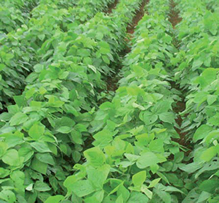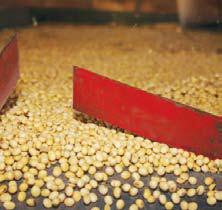Growing Soybeans101
 Soybeans are a leguminous vegetable of the pea family that grows in tropical, subtropical and temperature climates. It was domesticated at around 11th century in northeast China. It is believed it might have been introduced to Africa in the 19th century by the Chinese traders along the east coast of Africa.
Soybeans are a leguminous vegetable of the pea family that grows in tropical, subtropical and temperature climates. It was domesticated at around 11th century in northeast China. It is believed it might have been introduced to Africa in the 19th century by the Chinese traders along the east coast of Africa.
Soybean Variety Selection
Arguably the greatest tool in modern soybean farming is the ability to hand-select traits preferred in a soybean variety. Between disease and herbicide traits, maturity selection, and stand ability and shattering options, farmers can start the growing season with more control than ever over how the following months will go.
Later maturing soybean varieties tend to have higher yields, but the highest-yielding varieties aren’t always the most profitable for growers. It’s advisable to balance yield potential with other management costs.
There are always new traits and varieties being tested by seed companies and recently agricultural companies have been teaming up to get the latest seed technology in African fields.
Disease and constraints
Diseases in Africa include rust, red leaf blotch, frog-eye leaf spot, bacterial pustule, bacterial blight, and soybean mosaic virus. Pests include pod (stink bugs) and foliage feeders, bean flies and nematodes.
 Soybean rust, caused by the Phakopsora pachyrhizi fungus, attacks and destroys the leaves of the plant and can cause up to 60% yield loss. It is widespread throughout many parts of the world and is considered the most destructive of soybean foliar diseases.
Soybean rust, caused by the Phakopsora pachyrhizi fungus, attacks and destroys the leaves of the plant and can cause up to 60% yield loss. It is widespread throughout many parts of the world and is considered the most destructive of soybean foliar diseases.
Other problems include pod shattering that reduces seed longevity, and production and distribution difficulties. Dual-purpose improved varieties of soybean have not reached many soybean growers to increase production. In many countries only a small market exists for soybean so many farmers are not willing to grow it, and not many people know how to process it or prepare meals with it.
Importance
it consists of more than 36% protein, 30% carbohydrates, and excellent amounts of dietary fiber, vitamins, and minerals. It also consists of 20% oil, which makes it the most important crop for producing edible oil.
Malnutrition, particularly protein deficiency, is prevalent in many parts of Africa as animal protein is too expensive for most populations. Many leguminous crops provide some protein, but soybean is the only available crop that provides an inexpensive and high quality source of protein comparable to meat, poultry and eggs.
A by-product from the oil production (soybean cake) is used as a high-protein animal feed in many countries. Soybean also improves soil fertility by adding nitrogen from the atmosphere. This is a major benefit in African farming systems, where soils have become exhausted by the need to produce more food for increasing populations, and where fertilizers are hardly available and are expensive for farmers.
Production
More than 216 million tons of soybean were produced worldwide in 2007, of which 1.5 million were in Africa. Africa imports nearly as much soybean as it produces. Africa exports about 20,000 tons annually.
Nigeria is the largest producer of soybean in sub-Saharan Africa (SSA), followed by South Africa. Low yields and a shortage of fertilizer constrain the ability of some countries to increase production. In Nigeria the haulms and post-processed pulp (soybean meal) serve as important sources of animal feed. A 30% annual growth in the poultry industry from 2003 to 2008 fuelled such a demand for soybean meal that an increase in imports was required. Commercial soybean production on large farms takes place in Zambia, Zimbabwe and South Africa. However, it is mostly cultivated by small-scale farmers in other parts of Africa where it is planted as a minor food crop among sorghum, maize, or cassava
Consumption
Worldwide consumption of soybean is nearly 11 million tons. Africa consumes about 618,000 tons annually, and uses another 4,800 tons for animal feed. Nigeria is the largest consumer of soybeans in SSA followed by Uganda.
In Africa dry soybean is used to produce milk substitutes and flour. The bean curd is fried and eaten as a snack or breakfast food. Mature beans are not easily digested and contain toxic compounds, which require soaking and prolonged cooking.